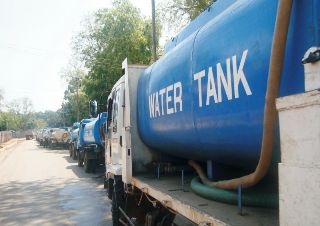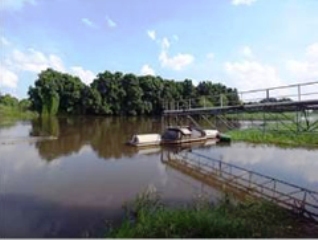Less than 60% of South Sudanese access clean water
By Julius N. Uma
December 27, 2015 (JUBA) – An estimated between 50-60 per cent of the population in South Sudan, has access to an improved water source, such as a hand pump, a protected well or piped water supply, which only benefits a minority.

Some buy water from vendors who use trucks to supply water to their customers.
Also, only 13 per cent of Juba residents can access municipal water supplied mainly through a small piped network, boreholes and a single public water filling station on the river bank. The public system is complemented by a patchwork of small private water suppliers, which end up delivering relatively expensive and low quality water.
There are about 300 registered trucks supplying water throughout Juba city. However, the delivery of water to households has decreased by 30 per cent as fuel has become expensive following the currency devaluation.
Currently, at least 11 private filling stations pump water from the Nile which is then distributed by water trucks and bicycle vendors. Water is also produced by bottling water factories. But as fuel costs have reportedly increased, operation overheads have also gone up by around 35 per cent.
“In the rainy season, communities lack drinking water. This often results into Cholera and diseases like diarrhoea. We worry a lot about our health,” Simon Biar, who lives in the South Sudanese capital, told Sudan Tribune.
“Our people drink water from any source regardless of the safety. Most times, we collect water from river Nile which is dirty and polluted,” he adds.
Mading Cienggan, a senior engineer at the country’s urban water corporation blames the poor supply of water on low power to supply the city, use of old water filters and the increase of water supply to new areas.
The Japanese government earmarked an additional fund for the Project for Improvement of Water Supply System of Juba, with total disbursement amounting to approximately $ 40 million to address the cost increase due to the political crisis and keep the project scale as originally planned.
This project aims to improve access to safe water for people in Juba by expanding the capacity of water treatment and scaling up water distribution. In this project, Japan set up a new water treatment plant, a service reservoir, eight water tank stations and 120 water points in Juba.
By the end of September 2017, officials say, as much as 390,000 of Juba residents will have ready access to safe drinking water at home, thereby enabling people to enjoy the rights to pursue lifestyles we wish to pursue.
“This project not only fulfills the basic needs of individuals but also facilitates the healthy and productive life of women and children in the communities. Reduction of the work for fetching water will immediately emancipate women and children from labor: women will have extra hours to engage in other employment opportunities, and children, in their turns, will learn better in the newly-gained hours of studies,” said Kiya Masahiko, the Japanese ambassador to South Sudan.
“Furthermore, improved public health through the use of safe, stable water supply will decrease the morbidity from waterborne diseases such as cholera, diarrhea and typhoid”, he added.
According to the United Nations Children Fund (UNICEF), only 45 per cent of basic primary schools in South Sudan have access to safe water while a mere 17 percent have adequate sanitation facilities for both girls and boys.
“As a result of limited access to safe water and adequate sanitation, a third of the children under the age of five suffer from diarrhea,” UNICEF said in recent report.
Access to safe water, adequate sanitation and hygiene promotion are all equally important; a combination of these elements are required to maintain and improve health and dignity. To prevent the spread of water-borne diseases and help improve hygiene and sanitation standards, a number of organizations in South Sudan are working on rebuilding and rehabilitating boreholes as well as larger water points.
Several residents in the South Sudanese capital admitted that access to adequate sanitation and improved hygiene practices is challenging to achieve since it requires change in behavior, especially among those in most need.

“A lot more is required”, says Taban, but added that “The community engagement process is vital to ensure meaningful and sustainable behaviour change process”.
As the world marked this year’s World Toilet Day, it emerged that latrines and toilets still elude many South Sudanese with only 13 per cent of the population accessing basic sanitation and 5.6 per cent of households in South Sudan have access to improved water sources and sanitation, the country’s 2010 Household Health Survey (SHS) showed.
According to UNICEF, lack of sanitation, and particularly open defecation, contributes to the incidence of diarrhoea and to the spread of intestinal parasites, which in turn aggravates malnutrition and increases the risk of diseases like Cholera especially for children less than five years.
It is estimated that more than 34.4 per cent of all children under-five in South Sudan suffer from diarrhoeal diseases every year due to poor sanitation practices.
Use of unsafe water for drinking, food preparation, hygiene, and lack of access to sanitation facilities contribute to around 88 per cent of deaths from diarrhoea in the world’s youngest nation, the 2010 SHS observed.
“We are failing children if we cannot come up with concrete and innovative solutions on proper disposal of human waste,” says Jonathan Veitch, UNICEF’s Representative in South Sudan.
“Lack of access to clean water and sanitation impacts children’s health, safety, education and survival. And for girls and women, poor access to safe and sanitary facilities puts them at greater risk of gender-based violence,” he added.
The Millennium Development Goal target for drinking water was reportedly achieved in 2010, but, in 2015, 663 million people still lack improved drinking water sources. The world missed the sanitation target by almost 700 million people, with 2.4 billion still lacking improved sanitation facilities and 946 million practicing open defecation.
(ST)
